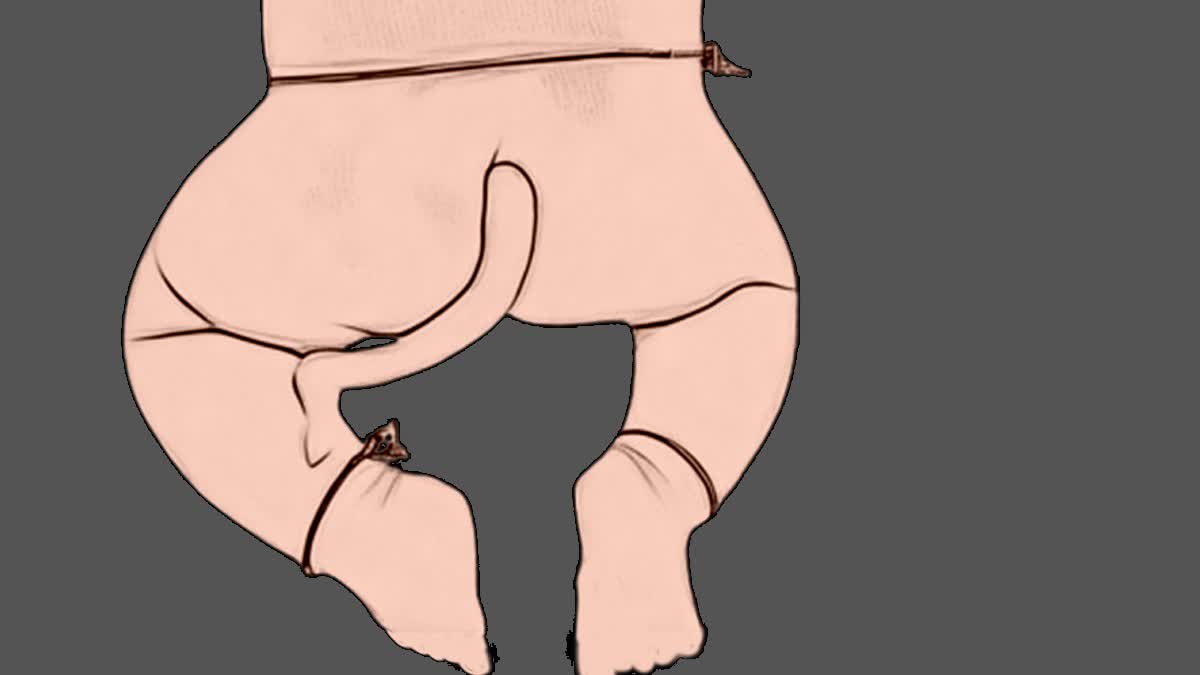Yadadri Bhuvanagiri (Telangana): In a rare medical case, doctors at the All India Institute of Medical Sciences (AIIMS), Bibinagar in Yadadri Bhuvanagiri district of Telangana successfully removed a 15 cm tail from a three-month-old male baby through a complex surgical procedure.
The surgery was performed in January this year and the infant was reviewed by a team of doctors at AIIMS Bibinagar on Monday. A spokesperson for the medical institute while divulging further details into the case said the surgery was carried out by Dr Shashank Panda, Additional Professor and Head of the Department of Pediatric Surgery and his team.
He said that the team operated on a rare case of human tail in the lumbosacral region on a 3-month-old male child. Human tails are very rare with only about 40 cases reported in the medical literature across the globe.
A Challenge For Doctors
What posed a challenge to the team of doctors was that the patient had associated occult spinal dysgraphia (distortion of the spinal cord due to fibrous bands) from S1 to S5 vertebrae and anchored spinal cord syndrome with a risk of neurological deficit requiring meticulous modification of surgical technique.
According to the AIIMS Bibinagar spokesperson, the post-op recovery was uneventful and the patient is having no neurological deficit at 6 months post surgery follow up.
Dr Shashank Panda, who led the surgery, said the operating time was around 2.5 hours. The baby is doing well after six months of follow-up without any neurological deficits, he added.
The doctor said that the fibrous bands connected with the spinal cord of the infant were dissected meticulously with repair of dura, the tough outermost membrane enveloping the brain and spinal cord. The surgery team consisted of two faculty members and one senior resident while the duration of hospital stay was five days.
What Are Human Tails
According to ScienceDirect, a website that provides access to a large bibliographic database of scientific and medical publications of the Dutch publisher Elsevier, human tails are rare congenital anomalies and describe protrusions located around the midline of the lumbosacral region covered by skin, representing an embryonic trace.
"Human tails are classified as true and pseudo-tails. The real ones represent the persistence of a remnant of the embryonic tail formed between the fourth and eighth week of gestation, being composed of adipose and connective tissue, blood vessels, muscle and nerve fibers. Pseudo-tails are protuberances basically composed of adipose or cartilaginous tissue and the presence of bone elements. True human tails are very rare, with approximately 40 cases reported in the literature," reads a 2021 study published in Journal of Pediatric Surgery Case Reports.
What Causes Human Tails?
According to WebMD, the world's leading website related to medical science, true human tails are exceedingly rare and are often referred to as archaic or even as oddities. They are also found twice as often in males as they are in females and are not found to be passed down within families.
"It's a commonly held belief that the origins of the human tail lie in the ancestors of humans. Scientists believe that humans eventually adapted out of needing tails and so no longer grow them. Some scientists, however, have recently speculated that vestigial tails are linked with abnormalities in the spinal cord and column. Specifically, these scientists see vestigial tails as a part of spinal dysraphism or of a tethered spinal cord," reads the article reviewed by Dr Dan Brennan, MD, an award-winning pediatrician.
What Are Human Tails Made Of?
As per the article, some common characteristics of a human tail are:
- They contain muscles, connective tissue, blood vessels, and nerves.
- They are always covered with skin and located on the tail bone.
- They can be as long as 13 centimetres.
- Sometimes, they can even move or contract.
- Human tails do not contain bone, cartilage, or the spinal cord.
Read More
- Pantoprazole Prescribed Most Often: 1 In 2 Medical Prescriptions Issued In India Deviate From Standard Guidelines, Says Study
- World Plastic Surgery Day 2024: From Priyanka Chopra to Anushka Sharma, B-Town Beauties Who Admit Undergoing the Knife
- Open Heart Surgery Sans Anaesthesia In Patna, Patient Undergoes Operation While Listening To Hanuman Chalisa
- A First in Indian Subcontinent: Dog Undergoes Non-Invasive Heart Surgery in Delhi




